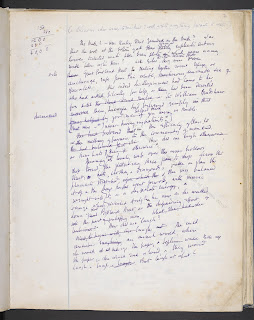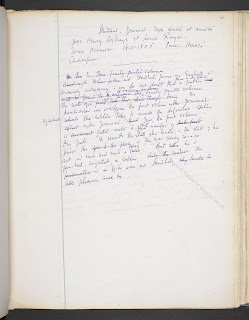Contained
within three notebooks,
below you can see parts of the working draft for one of Virginia
Woolf's
most famous novels, Mrs
Dalloway.
Dating from 27 June 1923 and originally titled 'The Hours', it was
published two years later as Mrs
Dalloway:
nn Britain by the Hogarth Press on May 14, 1925 with a dust jacket
designed by Vanessa Bell, and in the United States by Harcourt, Brace
& Company on the same day, with the same dust jacket.
Woolf
is acclaimed as an innovator of the English language. Here, in her
own handwriting, one can see her explore a new style of writing
called 'stream of consciousness', in which the imprint of
experience and emotion on the inner lives of characters is as
important as the stories they act out. By featuring their internal
feelings, Woolf allows her characters' thoughts to travel back and
forth in time, reflecting and refracting their emotional experiences.
This device, often known as 'stream of consciousness’, creates
complex portraits of the individuals and their relationships.
At
the end of each notebook we find notes and drafts for The
Common Reader. The essays were published by The Hogarth
Press in 1925.
The
character
of Mrs Dalloway
had already appeared in Woolf's first novel, The
Voyage Out,
as the wife of a Member of Parliament. By 1923, Woolf had conceived
the idea of writing a new story built around her. ‘I want to give
life and death, sanity and insanity,’ Woolf enthused in her diary,
‘I want to criticise the social system, and show it at work, at its
most intense’.
She criticised: in
Clarissa, the repressed social and economic position of women, and in
Septimus, the treatment of those driven by depression to the
borderlands of sanity.
During
her life, Woolf consulted at least twelve doctors, and
consequently experienced, from the Victorian era to the shell shock
of World War I, the emerging medical trends for treating the insane.
Woolf frequently heard the medical jargon used for a “nervous
breakdown,” and incorporated that language into her novel Mrs.
Dalloway. With the character Septimus Smith, Woolf
combined her doctor’s terminology with her own unstable states of
mind. When Woolf prepared to write Mrs. Dalloway, she
envisioned the novel as a “study of insanity and suicide; the world
seen by the sane and the insane side by side.” When she was editing
the manuscript, she changed her depiction of Septimus from what read
like a record of her own experience as a “mental patient” into a
more abstracted character and narrative. However, she kept the
“exasperation,” which she noted, should be the “dominant theme”
of Septimus’s encounters with doctors.
Mrs.
Dalloway (1925) is one of Woolf's two most loved and most
written-about novels, the other being To the Lighthouse (1925).
Set on a single June day in 1923, the novel tracks the parallel lives
of two very different Londoners, Clarissa Dalloway and Septimus
Warren Smith. Clarissa is a 51-year old socialite who is giving a
party that night for her husband, Richard Dalloway, a Conservative
member of Parliament. She moves in the upper reaches of British
society (the prime minister will attend her party), but she is not a
titled aristocrat, and she is thrilled about the prime minister's
actually showing up at the party. Woolf knew lots of people like
Clarissa, though they were not among her best friends. Most people
say Woolf modeled Clarissa on Kitty Maxse (1867-1922), who had been a
close friend of Woolf's two older sisters, Stella and Vanessa.
Although
characters related to each plot pass each other on the streets of
London during the course of the novel, the novel achieves its real
unity only in its conclusion, when Mrs. Dalloway learns of Septimus’s
death from his psychiatrist (one of the guests at her party) and
feels a strange sympathy for him. It seems that the knowledge of his
death prevents Clarissa from committing suicide herself. This
conclusion is troubling. Mrs. Dalloway does suggest that the poor
soldier’s suffering and death somehow redeem the apparently trivial
life of the hostess, who entertains nobility and politicians, the
“old men” that post-war society held responsible for the war.
Yet
Woolf also seems to be criticizing the logic that would justify
Septimus’s death as worthwhile, a fair price to pay for
“civilization.” Woolf called her novel an “elegy,” that is, a
lament for the dead, but she was skeptical of the traditional elegy’s
consolations, which she suspected of falsity. In her novel, the
living go on living, and they must recognize that the civilization
that permits them to do so is the same one that allowed millions to
die in the war.
In
the only introduction Woolf wrote for any of her novels, she says
that she originally intended that Clarissa would die in the novel,
perhaps by suicide (this is in the Modern Library edition published
by Random House in 1928). At some point, she decided to create
another character who would be the one to die. This new character was
Septimus Warren Smith, a 30-year-old, shell-shocked WWI veteran whom
we first meet in the street that Clarissa Dalloway is walking down.
Paralleling
Clarissa and Septimus thus allows Woolf to play out a range of
themes, while exploring the big topics that obsess her in all her
works, namely love, death, and the meaning of life.
Mrs.
Dalloway and Joyce's Ulysses
In
setting her novel on a single day in a city in June in a city through
which various characters walk while we listen in on their thought,
Woolf is obviously alluding to Joyce's Ulysses,
which had been published in 1922 and which she was reading that
summer that Mrs.
Dalloway began
to take shape. Ulyssesis
set on June 16, 1904, in Dublin, and is told primarily through the
thoughts of two main characters, Leopold Bloom and Stephen Daedalus,
whose lives intersect in complicated ways. Daedalus is a young man
much like Joyce himself, and Bloom may be seen as a father figure for
him.
Woolf
didn't much like Ulysses, or at least didn't appreciate what
Joyce was after. In her diary entries for August 26 and September 3
and 6, 1922 she says it's “pretentious, very obscure, tricky, and
that a good writer doesn't get so into doing stunts.” But something
about the structure must have struck a chord with her, perhaps
somehow giving her license to indulge her gift for detail.
Narrative
Technique
free
indirect discourse is
a term scholars use to describe the way narrative point of view
shifts in novels like Mrs.
Dalloway and
To the Lighthouse.
It's a modification of two standard modes of discourse we all
use:
direct discourse: Mrs. Dalloway said, “I'll by the flowers myself.”
direct discourse: Mrs. Dalloway said, “I'll by the flowers myself.”
indirect
discourse: Mrs. Dalloway said she would buy the flowers herself.
free
indirect discourse
when an author weaves a character's thoughts into the narrative in
such a way that it is hard to tell whether they are the character's
thoughts, someone else's thoughts about the character, or the
narrator's comments. In a single passage, such as the opening page of
Mrs. Dalloway,
Woolf may quickly shift from one character's perspective to another.
what
Woolf called “tunneling.”
going
deeply into each character's mind, there is a point when the mind of
one character and the minds of all characters become one. The term
tunneling comes from two diary entries written while Woolf was
writing Mrs.
Dalloway
Victorian
Treatment of Mental Illness and Woolf's Perception of it in Mrs.
Dalloway
- For many years, the dominant belief was that women were more likely to suffer from pathological grief than men.
- The "rest cure" was prescribed for Woolf many times. Physicians believed that by focusing on physical ailments, they could heal the mind.
- In MD, Woolf explores the harmful effects of "feminizing and medicalizing grief."That leaves Septimus devoid of avenues to express his sorrow. In Freud's terms, he suffers from "melancholia."
- Dr. Holmes, and Sir William Bradshaw, refuse to acknowledge Septimus's illness; they ask him to deny his self-consuming delusions.
THE ABOVE POST IS A COMPILATION OF INFORMATION INCLUDED IN SOURCES MENTIONED BELOW.
SOURCES:
http://www.uah.edu/woolf/lecture3_04.htmhttp://mrsdallowaymappingproject.weebly.com/mrsdalloway.html
https://modernism.research.yale.edu/wiki/index.php/Virginia_Woolf
https://www.bl.uk/collection-items/notebook-drafts-of-virginia-woolfs-mrs-dalloway-volume-ii
https://www.nytimes.com/books/97/06/08/reviews/woolf-dalloway.html
http://www.uah.edu/woolf/dalloway.html
























Comentarios
Publicar un comentario